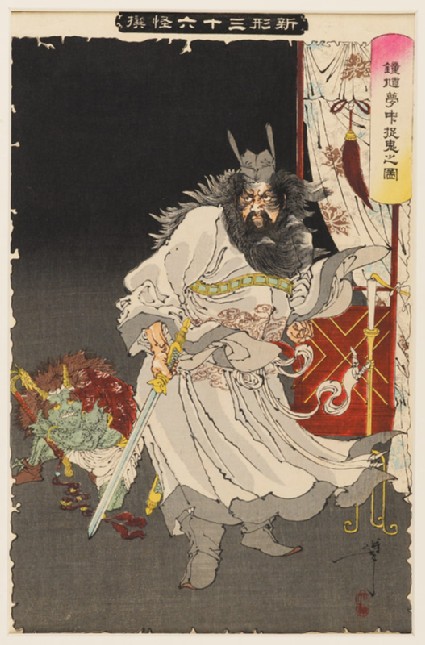Browse: 760 objects
- Reference URL
Actions
Shōki Capturing a Demon in a Dream
-
Description
Shōki is known as the Demon Queller. This name arose from a story involving the eighth-century Chinese Emperor Xuanzong who, troubled by demons, had become sick. Shōki appeared to him in a dream and demonstrated that he could quell the demons. He explained to the emperor that after failing his civil examinations he had committed suicide in shame. His way of helping the nation was to rid it of these malicious creatures. The Emperor was so relieved that he recovered and restored Shōki’s honour with a full ceremonial burial. Shōki is also depicted on the netsuke EA2001.90.
-
Details
- Series
- New Forms of Thirty-six Ghosts
- Associated place
- Date
-
probably 1890
Meiji Period (1868 - 1912)
- Artist/maker
-
Tsukioka Yoshitoshi (1839 - 1892) (designer)
- Material and technique
- nishiki-e (multi-block) woodblock print, with bokashi (tonal gradation)
- Dimensions
-
mount 55.5 x 40.3 cm (height x width)
print 35.5 x 23.7 cm (height x width)
- Material index
- Technique index
- Object type index
- No. of items
- 1
- Credit line
- Presented by George Grigs, Miss Elizabeth Grigs, and Miss Susan Messer, in memory of Derick Grigs, 1971.
- Accession no.
- EA1971.186
-
Further reading
Oxford: Ashmolean Museum, 23 April-22 September 2013, Manjū: Netsuke from the Collection of the Ashmolean Museum, Joyce Seaman, ed. (Oxford: Ashmolean Museum, 2013), illus. p. 20 fig. 23
Glossary (3)
Shōki, netsuke, nishiki-e
-
Shōki
Zhong Kui, or Shōki in Japanese, is a figure from Chinese folklore who appeared to the ailing 8th century Chinese Emperor Xuanzong in a dream and dispatched the demons that were haunting him. Shōki promised the Emperor that he would rid the world of demon
-
netsuke
The netsuke is a form of toggle that was used to secure personal items suspended on cords from the kimono sash. These items included purses, medicine cases or tobacco paraphernalia.
-
nishiki-e
Nishiki-e literally means 'brocade pictures' and refers to multi-coloured woodblock prints.
Past Exhibitions
see all (2)-

Tales in the Round: Manjū Netsuke and Japanese Woodblock Prints
(from 30th Apr until 22nd Sep 2013) -

Japanese Ghosts and Demons: Ukiyo-e prints from the Ashmolean
(from 29th Sep 2010 until 27th Feb 2011)
Location
-
- currently in research collection
Objects are sometimes moved to a different location. Our object location data is usually updated on a monthly basis. Contact the Jameel Study Centre if you are planning to visit the museum to see a particular object on display, or would like to arrange an appointment to see an object in our reserve collections.
© 2013 University of Oxford - Ashmolean Museum

